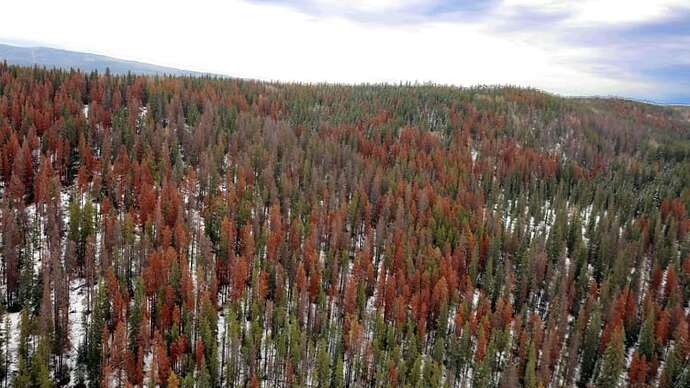‘Watching those beetle populations fall is really heartening’: Janice Cooke
Mountain pine beetle devastation in the Hinton, Alta., region in 2019. The red colour indicates dead trees due to pine beetles. (Government of Alberta)
In some good news for Alberta forests, mountain pine beetle populations have declined by 94 per cent since 2019, according to the province.
Janice Cooke, professor in the biological sciences department at the University of Alberta, said three things have contributed to this decline: lack of easy-to-attack pine trees, the recent cold temperatures and control measures by the province.
“It’s a great turn of events as far as our trees go,” Cooke told CBC’s Edmonton AM on Wednesday. “Watching those beetle populations fall is really heartening.”
Cooke’s research team studies trees and how they respond to pest insects and pathogens. Her team also monitors the cold and uses a mathematical model that predicts what the temperatures are doing to the beetles and how many are dying.
Jasper National Park stopped being a source for pine beetle populations after they ravaged most of the pine trees in the area.
This year, a longer fall season followed by extreme cold conditions that came earlier than expected resulted in killing off a significant number of pine beetles. Normally, northern Alberta would see back to back cold snaps during January and February.
Why the mountain pine beetle seems to have moved away from Alberta’s mountains
For years, mountain pine beetles have devastated forests in Jasper National Park. But it looks like there’s some good news on the horizon. The government says the Alberta pine beetle population has declined 94 per cent since a peak three years ago. Janice Cooke is a biology professor at the University of Alberta who studies trees and their relationship to pine beetles.
The cold snap in recent weeks that saw temperatures drop below -30 C helped further kill off pine beetles in northern Alberta, according to data collected by Cooke’s team.
Cooke also pointed to efforts by the provincial government to control pine beetle populations.
Crews identify trees attacked by mountain pine beetles and then cut and burn them on the spot so they can’t infect other trees the following year.
“Those things together have made this difference in the last few years,” she said.
Mountain pine beetles are the most destructive pine insect pest in Alberta and have affected more than 2.4 million hectares of Alberta forest, according to the province.
Although pine beetles have been a major issue since the early 2000s, they became especially problematic for northern Alberta in the past five years, Cooke said.
Cooke added they are not worried about lost trees since Alberta forests recover well.
“That is the glorious thing about our forests is they have great regenerative capacity,” she said.
-
Pine beetles advancing quickly across Alberta, new study finds
-
Cold snap killed 95% of mountain pine beetles in some areas of Alberta, says biologist
Pine beetles kill trees by producing a blue-stain fungi that clogs and destroys the tree’s conductive tissue. The province has 5.5 million hectares of pine that is in danger of being harmed by the insect.
Cooke cautioned that they were not out of the woods yet. Problem spots still exist in the Kananaskis, Bow Valley and Crowsnest Pass areas.
“And if we pretend like they’re not there, they’re going to become a problem,” she said.

